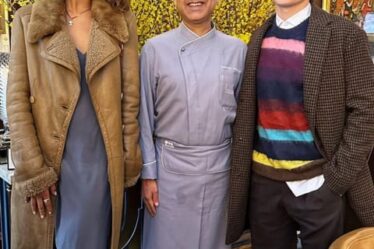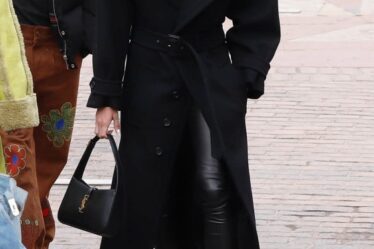
Founded by two influencers, Summer Fridays is about as digital savvy as a beauty brand gets. Its products, like its multi-hued lip butter balm and viral “Jet Lag” mask, seem made for Instagram, where the brand has over 1 million followers.
But lately, Summer Fridays has embraced the offline. Since 2021, it’s run several out-of-home advertising campaigns. It wrapped London taxi cabs in its imagery to hail its UK launch earlier this year and covered the sides of Hampton Jitney buses in 2023. Most recently, it even decorated TSA bins at airport security.
“We’re a social- and digital-first brand, but we don’t want to just reach the people that can see us on social [media],” said Summer Fridays co-founder Marianna Hewitt. “If it can be advertised on, we’re exploring it.”
For digitally-savvy beauty brands like Summer Fridays, a strong online presence got them into major retailers and on the wish lists of top investors. But the industry has changed — and to keep growing, they’re looking offline.
While digital marketing costs come down from their 2022 peak when Apple’s sweeping privacy changes caused headaches for marketers, online advertising is often irregular in its returns. Even when a campaign performs well, it still tends to reach shoppers already within the brand’s ecosystem, and is limited to those who regularly use social media.
“[Our customer] might be 20 years old… but also they might be much older,” said Alisa Metzger, co-founder of skincare maker Innbeauty Project, which has been embracing out-of-home advertising as the brand looks to build intergenerational appeal.
It’s also a way to cut through the clutter, said Ellen Yoon, a creative director at marketing communications firm VML. There’s so many indie and celebrity-backed beauty brands online that a real-world presence can feel like a differentiator.
Advertising offline, though, is different than doing so online. Crafting a strong out-of-home campaign requires skilled location targeting and diligent research to ensure any images, taglines or text will be easily understood and absorbed by casual passers-by. Companies must also calibrate their expectations accordingly; without the same easy trackability that digital marketing can offer, brands may have to accept more ambiguity in their results.
Plus, there’s an inherent paradox to consider. An impactful offline campaign will probably need to have some elements — be that a famous face, a heartfelt message or just arresting graphics — that encourage passers-by to share it online.
The Medium is The Message
On brands’ owned social channels and e-commerce sites, they can easily craft a universe with their own choice of colours, language and imagery to signal to visitors what their company stands for. With out-of-home advertising, however, they have a much smaller window to capture attention. As tempting as it might be to choose a more enigmatic tagline to pique interest, if brands opt for something too niche, they’ll confuse, rather than entice shoppers.
Patrick Ta Beauty, a prestige cosmetics line founded by the eponymous makeup artist, opted for the tagline of “beauty that brings you out” for its first major out-of-home campaign, which includes billboards, a Times Square ad, and a television spot. Jacqueline Barrett, the brand’s senior vice president of marketing said the tagline, which accompanies its campaign around self-realisation with a focus on the stories of first- and second-generation Americans, was meant to strike an emotional note.
“It taps into a really universal human truth … that has really struck a chord,” said Barrett.
The brand invested over $1 million in the campaign, a step up from its previous smaller effort of purchasing flag space above the high-traffic Sunset Strip in Los Angeles. Barrett said the brand has already seen a 40 percent increase in correlated search terms. “The beauty ecosystem on social [media] is really immersive, but there’s so many people who we want to expose to the brand that are outside of that sphere,” she said.
Yoon said sensorial images that show product texture are often impactful, as well actually showing real skin texture rather than going for heavy retouching. She also added that brands shouldn’t forget to include their logo in a prominent position.
Summer Fridays generally opts for its logo and a single product to spotlight in its advertising, often its moisturising Jet Lag Mask. Hewitt said she felt it was equally important to recognise the hero product as well as the brand itself, citing the memorability of the mask’s bright blue tube packaging.
“We need to assume the people seeing our advert are seeing the brand for the first time. They don’t know the inside jokes or the tagline,” she said.
Planning Ahead
Beauty brands looking to experiment with out-of-home ads also should consider the moment their campaign will have the greatest impact. . For Innbeauty Project’s first out-of-home campaign, for example, the brand carefully calculated its launch date, landing on a window when it was expanding its store footprint with Sephora, but also in a quiet period for new launches, so it could have a clearer idea of how much the campaign was contributing to its overall growth. Sales of the featured product, Extreme Cream, already a top-selling SKU, grew 800 percent in the first two weeks of the campaign, said Metzger.
The brand picked high-traffic locations in areas it already over-indexes in like New York, Miami, and Austin, Texas, “locations where we know our customer is just walking around, grabbing a coffee,” she said.
If only a single product is featured in a campaign, it’s easier for a brand to see a sales uptick, but otherwise, they have to rely on tools like social listening and brand awareness surveys to measure impact. “You can’t analyse the data in real time, and you can’t A/B test,” said Metzger, but adding that they are carefully tracking all the social media tags and mentions they get, as well as monitoring web traffic through QR code scans.
While detailed trialling isn’t possible, brands can test the waters with wild posting (posters pasted on buildings, walls or sides of streets) first and see what the consumer response is before committing to a more extensive campaign.
One strategy to help maximise the impact of out of home advertising is banking on the halo effect from another well-known name. Hewitt said Summer Fridays often chooses to advertise near a Sephora, one of its top retailers, or include copy that indicates its availability there to help increase conversion.
“That way, Summer Fridays is one of the last things you see before you walk into the store,” she said.
Another is to leverage the power of creators and talent in a brand’s network, especially those who have proven their ability to convert customers online. Patrick Ta’s campaign included the models Shannon Zhao and Roseline Angua; Innbeauty’s featured the creator Hannah Chody amongst others, while Summer Fridays London efforts featured the British model Christina Nadin.
That also helps the ads to gain traction online, too. With big, but still nascent followings, all of those faces were eager to post their own content proudly showing off their inclusion in the campaigns, with their fans and family often doing the same, increasing its reach. Summer Fridays’ TSA takeover at a time when photos of what’s in your bin are trending on TikTok, is another example of bridging the offline with the online.
“We’re not the hugest brand and we don’t have big celebrities,” said Hewitt. “But being in an ad encourages [the talent’s] followers, friends and family, to share as well.”
Sign up to The Business of Beauty newsletter, your must-read source for the day’s most important beauty and wellness news and analysis.


